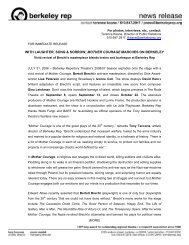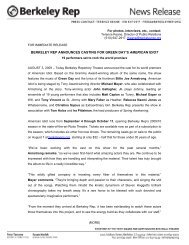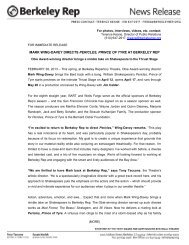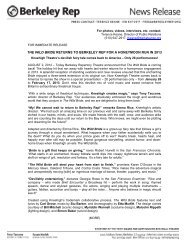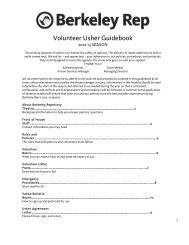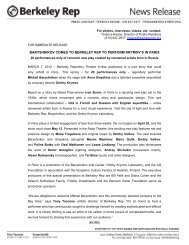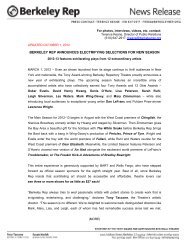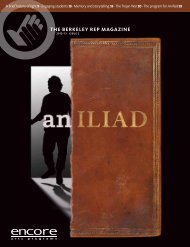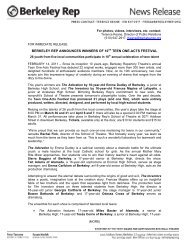Pre-Show Discussion Questions: - Berkeley Repertory Theatre
Pre-Show Discussion Questions: - Berkeley Repertory Theatre
Pre-Show Discussion Questions: - Berkeley Repertory Theatre
Create successful ePaper yourself
Turn your PDF publications into a flip-book with our unique Google optimized e-Paper software.
Study guide written and compiled by<br />
Dave Maier, Outreach Coordinator<br />
Shannon Howard, Education Intern<br />
Student Matinee Study Guide<br />
Argonautika<br />
WRITTEN AND DIRECTED BY MARY ZIMMERMAN<br />
ADAPTED FROM THE VOYAGE OF JASON AND THE ARGONAUTS<br />
IN ASSOCIATION WITH MCCARTER THEATRE CENTER<br />
AND THE SHAKESPEARE THEATRE COMPANY
Study Guide Table of Contents<br />
Letter from the Outreach Coordinator 3<br />
Re-examining the Hero Myth 4-5<br />
Jason's Family Tree 6-7<br />
<strong>Pre</strong>-<strong>Show</strong> Investigations 8<br />
Argonautika Cast and Crew 9<br />
<strong>Pre</strong>-<strong>Show</strong> <strong>Discussion</strong> <strong>Questions</strong> 10<br />
Post-<strong>Show</strong> <strong>Discussion</strong> <strong>Questions</strong> 10-11<br />
Critical Thinking: Leadership in Myth and the Real World 12<br />
Spotlight on <strong>Theatre</strong> Arts: Props Design 13-15<br />
Study Guide Activities 15-16<br />
2
Letter from the Outreach Coordinator<br />
Dear Educator,<br />
Welcome to the Argonautika study guide. We hope you will find it useful and<br />
that it will give you and your students some insight into the magical work of<br />
this production. We know that each classroom is different, and we urge you to<br />
use this material to suit the needs of your students.<br />
With that in mind, we have provided background information, discussion<br />
questions, and language arts activities designed to help you find the lens<br />
through which your class will get the most out of Argonautika. We hope that<br />
you will find it useful.<br />
Please, let us know how this study guide enhances your experience of the play.<br />
Send comments and suggestions to dmaier@berkeleyrep.org. We look forward<br />
to hearing from you.<br />
Sincerely,<br />
Dave Maier<br />
Outreach Coordinator<br />
<strong>Berkeley</strong> Rep School of <strong>Theatre</strong><br />
3
Jason and Medea: Re-examining the Hero Myth<br />
By Lila Neugebauer, Literary Intern<br />
(from right) Jason (Jake Suffian) woos Medea (Atley Loughridge) in the West Coast premiere of Argonautika, an exhilarating new adventure from<br />
Tony Award-winner Mary Zimmerman at <strong>Berkeley</strong> Rep. Photographer: Kevin Berne.<br />
Jason’s quest for the Golden Fleece is among the oldest of Greek legends. The story’s archetypal simplicity is<br />
strikingly familiar: a hero is sent to retrieve an extraordinary prize and must perform seemingly impossible feats to<br />
obtain it. For the leading scholar of myth, Joseph Campbell, Jason epitomizes the hero figure at the core of all<br />
mythology.<br />
Campbell’s hero can be a prince, a warrior, a saint, or a god; the “boon” he brings back may be a material prize, a<br />
bride, or wisdom. Prometheus retrieves fire from the heavens for mankind; Jason circumvents the dragon and obtains<br />
the golden fleece; Aeneas voyages into the underworld and communes with his deceased father. In all of these<br />
journeys, Campbell identifies a symbolic quest for identity. Many hero myths are figured as a return to the father—<br />
Jason’s reunion is symbolic: he returns to assume his father’s rightful throne. Campbell reads this search as,<br />
fundamentally, the search for the self.<br />
The motif is common in fairy tales—the hero usually a prince, the prize often a bride. The Argo’s voyage closely<br />
resembles the body of folklore in which a prince secures his prize with the help of companions possessing magical<br />
talents. An oft-cited parallel is the Brothers Grimm tale The Six Servants, in which a prince succeeds in marrying a<br />
beautiful maiden whose witch-mother seeks to deter suitors with a series of treacherous challenges. En route to his<br />
future bride, the prince is joined by six men, each possessing a unique physical attribute that proves vital to<br />
surmounting the six obstacles the witch presents.<br />
The Medea-Aeetes-Jason story belongs to yet another, even more pervasive folk motif common to tales around the<br />
world: a man facing a series of trials in a foreign kingdom is aided by the daughter of his hostile host, who thereafter<br />
abandons her own family and kingdom to elope with him. The Norse Mastermaid and Gaelic Battle of the Birds feature<br />
the same theme. Within the Greco-Roman tradition, Hippodamia sabotages her own father’s chariot and causes his<br />
death so that her future husband can win the race; Ariadne famously arms Theseus to defeat the minotaur, fleeing her<br />
kingdom thereafter to marry him.<br />
Medea’s role in the legend makes a near irony of the original folk motif of happy helpers: her extraordinary magic<br />
renders the talents of the Argonauts inconsequential. It is Medea’s sorcery alone that enables Jason to obtain the<br />
4
fleece, her power that earns him his heroic status. Jason’s success lies in winning Medea’s love; his heroic virtues are<br />
seemingly charm and good looks. He is, after all, the first of many ordinary men to play the hero’s part in western<br />
literature.<br />
This chapter in Medea’s story remains unknown to many, even those who are well-versed in classical mythology. She<br />
is more widely recognized as Euripides’ “barbarous monster,” the mother who commits the unimaginable, the murder<br />
of her own two sons. Abandoned by Jason so that can he obtain a throne by marrying a Greek princess, Medea is left<br />
alone and homeless in a foreign land; she has betrayed and abandoned her family and kingdom for Jason’s survival<br />
and glory. It is easy to forget that she was a young girl who fell in love under the gods’ hands, who was promised<br />
marriage, family, and home. Apollonious’ epic Argonautika, from the third century BC, depicts a strikingly complex<br />
psychological portrait of a young girl alone in the depths of her native woods, agonizing over the betrayal she fears she<br />
will commit, but sick and chilled with the pangs of first love. Jason and Medea’s romance is recognized as the first<br />
love story of the western tradition.<br />
Yet how does Medea’s critical role in Jason’s “decisive victory” fit into Campbell’s monomyth? She is not Jason’s bridal<br />
“boon”; the fleece is his prize. While his quest entails a return to the father, it necessitates Medea’s betrayal and<br />
abandonment of hers. A princess’s desertion of her family seemingly supports the regenerative logic of marriage and<br />
procreation; the folk motif justifies the break young must make from old in our cultural order. But Jason readily<br />
discards Medea for a potential throne—for the social role and status he journeyed to obtain. If that betrayal is a<br />
necessary step in Jason’s heroic initiation into manhood, what conception of heroism does this story espouse?<br />
Despite our hero’s casual cruelty, his epic voyage continues to captivate the western imagination. Nathaniel<br />
Hawthorne introduced American children to the legend in his Tanglewood Tales (1851), and Charles Kingsley did the<br />
same for the British with his collection, Heroes (1855). This nineteenth-century trend of adapting the tale for young<br />
people has made the story a mainstay of children’s books since. Myths, like fairy tales and fables, function not only as<br />
entertainment, but also as pedagogy. We read them to our children in the hopes that they will prove instructive: stray<br />
from the path and a nasty wolf might eat you up; a candy house may look inviting, but greediness could get you boiled<br />
by a witch. They are primers, guidebooks for the roles and responsibilities we assume when we enter the adult world;<br />
their conventions become encoded in our everyday lives, in the social customs through which we build our<br />
relationships to one another. Campbell tells us these stories help us learn how to live. They also, of course, reveal a<br />
great deal about how we already do live.<br />
A scene from Mary Zimmerman's production of Argonautika at <strong>Berkeley</strong> Rep. Photographer: Kevin Berne.<br />
5
<strong>Pre</strong>-<strong>Show</strong> Investigations<br />
Argonauts: The Next Generation<br />
After you study Jason’s family tree, proceed to this research activity.<br />
Members of the Argo’s crew are famous for achieving great deeds on board the Argo. Some of them also<br />
had famous parents and relatives, many of whom were gods and goddesses.<br />
The next generation of mythic characters went on to achieve great deeds, too. Using your favorite search<br />
engine, enter these names, and discover the famous children of the Argonauts below. (note: this list may<br />
include characters who were not depicted in the production of Argonautika but who, according to legend,<br />
may have been a part of the expedition)<br />
Then connect the research to literary works with which you are already familiar. Depending on your<br />
grade level and curricular content, you may wish to isolate one particular family tree and discuss it with<br />
your classmates. How might one family leave an enduring mark on our culture through its depiction in<br />
various ancient myths?<br />
Jason Laertes Meleager<br />
Castor Argus Argus<br />
Pollux Laocoon Andromeda<br />
Acastus Medea<br />
Idmon Atalanta<br />
Athena is helping a crew member erect the sail, while Argus is building the ship, 50 AD Roman relief.<br />
8
erkeley repertory theatre, in association with<br />
the shakespeare theatre company, mccarter theatre<br />
center, and lookingglass theatre company, presents<br />
the west coast premiere of<br />
ARGONAUTIKA<br />
Cast<br />
Hera Christa Scott-Reed*<br />
Jason Jake Suffian*<br />
Athena Sofia Jean Gomez*<br />
Pelias and others Allen Gilmore*<br />
Idmon and others Jesse J. Perez*<br />
Meleager Andy Murray*<br />
Castor and others Chris Kipiniak*<br />
Pollux and others Casey Jackson<br />
Hercules/Aietees Søren Oliver*<br />
Hylas/Dymas Justin Blanchard*<br />
Andromeda and others Ronete Levenson<br />
Amycus and others Paul Oakley Stovall*<br />
Aphrodite and others Tessa Klein*<br />
Medea Atley Loughridge*<br />
Scenic Design Daniel Ostling<br />
Costume Design Ana Kuzmanic<br />
Lighting Design John Culbert<br />
Sound Design & Andre Pluess<br />
Original Composition & Ben Sussman<br />
Puppetry Design Michael Montenegro<br />
Stage Manager Cynthia Cahill*<br />
Casting Amy Potozkin<br />
*Denotes a member of Actors’ Equity Association, the Union of Professional Actors and Stage Managers of the United<br />
States<br />
9
ARGONAUTIKA<br />
<strong>Pre</strong>-<strong>Show</strong> <strong>Questions</strong>:<br />
Thank you for spending an afternoon with us at <strong>Berkeley</strong> <strong>Repertory</strong> <strong>Theatre</strong>! Before seeing the show, we offer you these topics<br />
to consider. These questions and activities will help your class become acquainted with the major ideas in Argonautika.<br />
1. What qualities do you value in your leaders at home, at school, or in your community? How does a<br />
leader earn and keep your trust?<br />
2. What are some common obstacles all travelers may face when they leave home?<br />
3. How can travel bring people closer together? In what ways can it drive us apart?<br />
4. What is your definition of hospitality?<br />
5. What role does hospitality play in your community?<br />
6. Prophecies and prophets are often a part of Greek mythology. Do we have an equivalent of prophecy<br />
today? If so, what or who is it?<br />
7. Is falling in love a negative or positive experience? Why?<br />
8. Joseph Campbell, a mythology scholar, speaks of “the return” as one of the most challenging parts of<br />
any hero’s journey. Why might coming home be difficult for someone who has been away for a time?<br />
Post-<strong>Show</strong> <strong>Questions</strong>: Act I<br />
1. When we first meet Jason, he is performing a random act of kindness for an elderly woman. How does<br />
this act shape the later events in his life?<br />
2. If you boarded the Argo as a passenger, which member of the crew would you trust the most, and why<br />
would you trust him or her?<br />
3. Why are the women of Lemnos given such a prominent role in the telling of this story? What can we<br />
learn from them?<br />
4. When Hylas and Hercules stray from their crewmates, members of the Argo expedition wish to leave<br />
them behind. Others argue that it is unfair to leave a comrade behind. Who is right?<br />
5. As the Argonauts travel toward Colchis, they meet Phineus, a prophet, who is punished by the gods for<br />
knowing too much about his own future. Why do you think this scene is included?<br />
10
Post-<strong>Show</strong> <strong>Discussion</strong>: Act II<br />
1. When Jason meets the king of Colchis for the first time and asks him to turn over the Fleece, the king refuses and<br />
then threatens Jason and his men. Who, do you think, ultimately has the right to the Golden Fleece?<br />
2. Why is Eros, or Cupid, characterized as a young brat who refuses to obey others?<br />
3. Medea’s desire for Jason eventually causes great suffering to those closest to her. Although Jason uses<br />
Medea to win the Fleece, Hera is actually the one who engineers the entire affair between the lovers.<br />
What does this suggest about free will?<br />
4. How might the Argonauts’ adventures at Colchis have been different if Hercules had remained on<br />
board the Argo?<br />
5. Rather than remain with Medea, Jason chooses to marry someone from Thessaly in order to regain the<br />
throne of Thessaly. Medea, however, betrays her family to retain Jason's love. Ultimately, who was right--<br />
Jason, or Medea? Why?<br />
6. Why is the telling of myth still important in the 21st century? What stories do you think future<br />
generations will tell about our society today?<br />
(from right) Hera (Christa Scott Reed) teases Aphrodite (Tessa Klein) in the West Coast premiere of Argonautika. 11
Critical Thinking: Leadership in Myth and in the Real World<br />
In the article “Re-examining the Hero,” the writer notes that Jason as a hero of ancient myth is a flawed<br />
protagonist, one who “readily discards Medea for a potential throne.”<br />
Leaders who are entrusted with power often react in different ways, especially once they achieve their<br />
goals and face the daunting task of returning home with overwhelming responsibility. In the columns<br />
provided below, list both Jason's positive use of power and his abuse of it in the later portions of the story.<br />
Jason’s Positive Use of Power Jason’s Abuse of Power<br />
Carries Hera across a river Asks Medea to betray her family<br />
Now that you’ve focused on Jason, recall the role of Hera as a goddess and leader in the production you<br />
just saw. Complete a similar list for how she uses her power as an immortal.<br />
Hera’s Positive Use of Power Hera’s Abuse of Power<br />
Protects Jason while he is at sea Tries to kill Hercules with serpents<br />
Throughout history, many leaders have struggled with using power effectively. Think carefully about one<br />
of these leaders from the history of your own culture, and make the same list below.<br />
Once you've started thinking critically about power, you may wish to make similar charts for characters<br />
you've encountered in literary works you are currently reading in class.<br />
Finally, you may wish to reflect on a time when you or someone you knew struggled with power, and then<br />
evaluate the behavior accordingly. When have you used power in a positive manner? Has power ever had<br />
a negative effect on the way you treat others?<br />
__________'s Positive Use of Power __________'s Abuse of Power<br />
__________'s Positive Use of Power __________'s Abuse of Power<br />
12
Object Lessons<br />
<strong>Theatre</strong> Arts: Spotlight on Properties Design and Artistry<br />
Throughout the production you just saw, actors held various objects in their hands in order to help us<br />
understand a story. These items are called props. Read the list below, and see if you can recall the<br />
function and the importance of each of the following props in Argonautika. How do props help tell the<br />
story of Jason's voyage in this play?<br />
SANDAL ROPE LANTERN ROCK<br />
OAR EYE DRUM CUP<br />
SCARF ARROW BALL RAM<br />
The writers of this study guide had a chance to meet Tom Aberger, Production Manager, and with Darcy<br />
Engel, props department intern, at <strong>Berkeley</strong> <strong>Repertory</strong> <strong>Theatre</strong>.<br />
What exactly is a props artisan, and what skills do you require when you hire personnel to work on a<br />
show at <strong>Berkeley</strong> Rep?<br />
A person who works in props is really a "jack of all trades." He or she should have a wide range of skills<br />
and be able to solve problems for many different types of productions. Whether the person is<br />
upholstering and building furniture for Heartbreak House (a play staged earlier this year at <strong>Berkeley</strong> Rep)<br />
or working with the electrics department to create stars and constellations in Argonautika, each member<br />
of the props team faces different challenges.<br />
Can you describe the production process involved in working on a show like Argonautika?<br />
Well, some props we use originated from Lookingglass <strong>Theatre</strong> Company, where the show was first<br />
staged. Our department inherited a number of objects, but had to improve on or repair them during the<br />
rehearsal run. Even during the rehearsal, the designers continue to comment on what they want and how<br />
they wish to improve on it. There is a great deal of collaboration.<br />
As a student, one option of learning more about props or other fields of theatre is to become an<br />
intern at a company like <strong>Berkeley</strong> Rep. Why is this an important part of a theatre career?<br />
Every show we do is different. Interns are faced with all kinds of projects that they may never have a<br />
chance to get their hands on outside of a professional theatre. The kind of problem solving involved on<br />
one show is different from on another show. Plus, some interns have experience with building, but may<br />
never have worked with puppets or with the process of making masks. They can fill in the holes of their<br />
education.<br />
As the intern, Darcy works under the guidance of Ashley Dawn, head of the props department, and gains<br />
access to a professional design crew who helps bring the visions of Mary Zimmerman, director, and Dan<br />
Ostling, set designer, to life. She answered our questions about her work on Argonautika and her<br />
previous education in the area of props design.<br />
As an intern who is working on different projects at <strong>Berkeley</strong> Rep, what do you think is the most<br />
challenging aspect of creating props?<br />
Being able to “fake it.” You have to make something look realistic when it isn’t real at all. Even food,<br />
which seems like it can be eaten, can’t be if it functions as a prop for a show. Some of the bread you see in<br />
13
Argonautika, for example, is made of carved foam. Since it’s not always possible to have the real thing,<br />
that’s where the creativity comes in.<br />
One of the most important things is having an understanding of what the actors have to hold or use, and<br />
what they need to do, and how to accommodate that and be appropriate to the show’s design.<br />
Everything has to be functional as well as realistic. And of course, safety is very important, so one of the<br />
spears in Argonautika, for instance, held by a goddess who flies through the air on a harness, is an almost<br />
weightless piece of PVC pipe that looks like a spear. Obviously no actor wants to risk carrying a heavy<br />
object when they are performing a stunt.<br />
What other props challenged you as a member of the props crew during preparation for Argonautika?<br />
I would say the breaking oar that Hercules holds when he races was the biggest challenge. Our struggle<br />
was to come up with a new solution to this problem, since it had given other theatres trouble in the past.<br />
We had to find out a way to keep him from being self-conscious, you know, so he wouldn’t worry about<br />
the oar falling apart while he was using it and he wouldn’t have to hold two pieces in his hands<br />
throughout the entire scene.<br />
First, we cut the oar in half and put a piston in it and had hardware put into it, so that when Hercules<br />
pressed a button, it would release the bottom half of the oar so that he could totally control it. But the<br />
weight of the broken piece was too heavy, and it flopped around. So we finally decided to use magnets to<br />
stick and unstuck the two pieces together. Now it’s strong enough to hold while he uses it, but it’s also<br />
made so that Hera can rip it apart.<br />
From past shows, which prop have you made that played a significant role in developing the story on<br />
a literal level but also acted as a symbol on a figurative level?<br />
When I designed props for Anthony Shaffer’s Sleuth, I had to build “the laughing sailor,” which was a<br />
carnival toy box with a mannequin inside, a gypsy fortune teller. The main character, Andrew, who<br />
owned it, had this line about living alone and having a horrible relationship w/his wife, and his life is just<br />
one big game, a joke. So the prop actually represented the character who had been cheated on by other<br />
characters in the show.<br />
What about for Argonautika? Which prop had special symbolic significance for you as a crew member<br />
and for the designers of this show?<br />
I worked on a miniature box, called an image box, which was a scaled down version of a location<br />
mentioned in the text. It had mountains and trees inside to represent one of the lands where Jason<br />
travels. At several points in the show we see landscapes inside 3 different boxes, hanging from pipes in<br />
the theatre above the action on the theatre floor. They each come in at a different time.<br />
14
Can you walk us through a process of making one particular prop for this show?<br />
I worked on the “clashing rocks” Jason faces on his journey, and these are the steps I used to create them:<br />
1. I found two blocks of wood. I wanted a certain sound of rocks hitting, which means I had to experiment with<br />
hitting many types of wood to get it right. I settled on two 4x4 chunks to serve as the rocks.<br />
2. Using a bandsaw with a vertical blade to make detailed cuts and shapes, I carved the wood to get a rounded<br />
shape like a rock.<br />
3. I painted the blocks with primer, which is the first coat of paint you put on a surface so that additional coats will<br />
stick to it.<br />
4. After putting on primer, I used texture spray paint to make the objects look like granite. You can get those types<br />
of spray at any crafts or hardware store (People use it in their own yards with pots and lawn ornaments). I sprayed<br />
at least two coats.<br />
5. I finished with a coat of dark brown spray paint to make the final appearance look realistic.<br />
ARGONAUTIKA Study Guide Activities<br />
Argonautika is told in a highly theatrical style that incorporates the use of props, costumes, movement,<br />
rhythm and character. These exercises are designed for middle school through high school. The activities<br />
are sequential and may be adapted for your particular classroom.<br />
Exercise #1: Create a New Myth<br />
Step 1: Gather random objects (example: tape dispenser, football, frying pan, cowboy hat).<br />
Step 2: Divide the class into groups of four or five. Give each group an object at random.<br />
This is the sacred object of their imaginary culture.<br />
Step 3: Choose one member of the group to be the scribe (or they can take turns). Then have each group<br />
come up with a story that includes:<br />
• The Origin of the object - where does it come from and why is it so important to the<br />
culture?<br />
• How the object was lost?<br />
• Who were the heroes that brought the object back?<br />
• Include three obstacles that these heroes had to overcome.<br />
• In the end, what price did they have to pay to accomplish this task?<br />
15
Note: Stress the importance of collaboration during this process. Each group member should make a<br />
contribution.<br />
Step 4: Have the groups read these myths to the class or move on to…<br />
Exercise #2: Frozen Tableaus<br />
This exercise builds on the previous activity of myth creation.<br />
Step 1: Instruct each group to identify six key points in their myth:<br />
• The beginning<br />
• The first obstacle<br />
• The second obstacle<br />
• Gaining the object<br />
• The journey home<br />
• What happens afterward<br />
Step 2: Instruct each to create five frozen pictures or tableaus depicting these events. Each group<br />
member should be in each tableau. If there are not enough characters in a scene, actors can also play<br />
objects or create the environment (actors can play the mountains, or water, a chair or a boat).<br />
Step 3: <strong>Pre</strong>sent these tableau to the class.<br />
Exercise #3: Cultural Exchange<br />
This activity requires that you have completed exercise #1 but not necessarily exercise #2.<br />
Step 1: Once each group has established a new myth based on their object, they should choose a name<br />
for their group of people.<br />
Step 2: Instruct the groups that they are to take part in a cultural exchange. They are going to relay the<br />
story of their myth to the other groups. They can choose one of the following forms to share their story:<br />
• Create a song<br />
• Create a dance<br />
• Create a play<br />
The choice should be based on what they know about their culture and on what they think would be fun<br />
to do. All group members should be included! Note: These should be short works of art that can be<br />
presented all together in one period. However, this exercise can take several periods if your schedule<br />
permits. If you have access to simple costume pieces or musical instruments, you may wish to make<br />
them available to the students.<br />
Step 3: Have each group present their work of art to each other.<br />
Step 4: Discuss the differences and the similarities between the group myths.<br />
Step 5: If you have seen Argonautika, discuss the differences and similarities in the production versus<br />
what the students created in class.<br />
16
THE MOSSE FOUNDATION FOR THE ARTS AND EDUCATION<br />
Celebrate our 40th anniversary with us this school year!<br />
Classes and outreach programs are available for all ages in<br />
Playwriting<br />
Acting<br />
Stage Combat<br />
Directing<br />
Voice<br />
….and more !<br />
Winter Classes Start January 14.<br />
For more information about upcoming events, teacher training workshops, classroom outreach,<br />
and opportunities for teen leadership, visit berkeleyrep.org/school, or call 510 647-2972.<br />
<strong>Berkeley</strong> Rep School of <strong>Theatre</strong> Staff<br />
Director Rachel L. Fink<br />
Associate Director MaryBeth Cavanaugh Special thanks to<br />
Outreach Coordinator Dave Maier Madeleine Oldham<br />
Education Associate Gendell Hernández Lila Neugebauer<br />
Administrator Jessica Modrall Tom Aberger<br />
Education Intern Shannon Howard Darcy Engel<br />
School of <strong>Theatre</strong> programming made possible by<br />
Thanks<br />
Bank of America Morrison & Foerster Foundation<br />
Bank of the West Mosse Foundation for the Arts and Education<br />
California Arts Council Pixar Animation Studio<br />
City of <strong>Berkeley</strong> Civic Arts Commission S.D. Bechtel, Jr. Foundation<br />
Crescent Porter Hale Foundation San Francisco Foundation<br />
David B. Gold Foundation Thomas J. Long Foundation<br />
Frank H. & Eva B. Buck Foundation van Loben Sels/Rembe Rock<br />
J.M. Long Foundation Walter & Elise Haas Fund<br />
Koret Foundation Woodlawn Foundation<br />
McKesson Foundation Zellerbach Family Foundation<br />
With additional funding provided by:<br />
Armanino McKenna Mechanics Bank<br />
Bayer HealthCare Oakland Fund for the Arts<br />
Civic Foundation Ruegg & Ellsworth<br />
Clif Bar<br />
17




